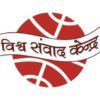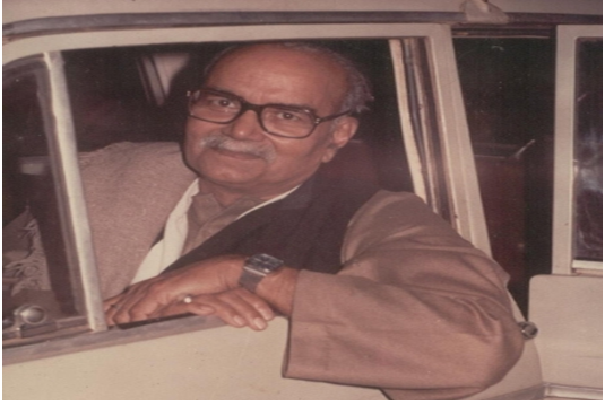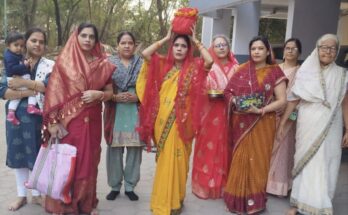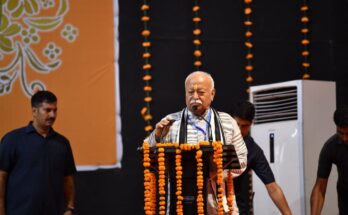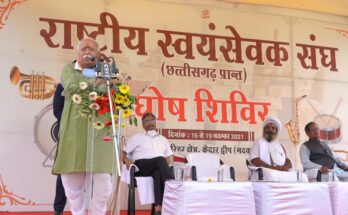Remembering Rajju Bhaiyya – A Nuclear scientist who solved the puzzles of a nation
Prof. Rajendra Singh (29 January 1922 – 14 July 2003 ), popularly called Rajju Bhaiya, was the fourth Sarsanghchalak of the Rashtriya Swayamsevak Sangh (RSS). He was Sarsanghchalak between 1994 and 2000.
He worked as a professor and head of the Department of Physics at Allahabad University but left to devote his life to the RSS in the mid-1960s.
Rajendra Singh was born to Jwala Devi and Balbir Singh on 29 January in 1922 in Shahjahanpur city of Uttar Pradesh, when his father was posted there as an engineer. Originally his father Balbir Singh belonged to village Banail Pahasu of Bulandshahr district. Rajju Bhaiyya matriculated from Unnao. After that he was enrolled at the Modern School (New Delhi) for a brief period before moving to St Joseph’s College, Nainital. Progressing to Allahabad University, he obtained B.Sc. and M.Sc. degrees.
Rajju Bhaiyya was acknowledged as an exceptionally brilliant student by Sir C. V. Raman, the physicist and Nobel Prize-winner, when he was his examiner in M.Sc. He also offered Singh a fellowship for advanced research in nuclear physics. He joined Allahabad University after majoring in Physics to teach Spectroscopy. He taught at the university for several years, where later he was appointed head of the Physics Department.Rajju Bhaiyya was also considered an expert in nuclear physics which was very rare those days in India. He was a very popular teacher of the subject, using simplicity and clear concepts.
With RSS:
Singh was active in the Quit India Movement of 1942 and it was during this time that he came in contact with the RSS. From then onwards the Sangh influenced his life. He resigned from his university post in 1966 and offered full-time services to the RSS as a ‘prant pracharak’. Beginning in Uttar Pradesh, Singh progressed to be the Sar Karyavaha (General Secretary) in the 1980s. In 1994, he was nominated to succeed Bala Saheb Deoras as RSS chief.
While in Uttar Pradesh, Singh worked with Lal Bahadur Shastri, Chandra Shekhar and V.P. Singh. Murali Manohar Joshi was one of his best students.
Arguably Rajju Bhaiya’s term of six years was one of the most crucial for both Sangh and India. Rajju Bhaiyya shared an excellent rapport with political leaders cutting across ideological lines besides academicians, social workers and intellectuals.
He abdicated the post of Sarsanghchalak on account of his failing health in February 2000 and nominated Shri K. S. Sudarshan for the post.
During emergency he went underground and toured whole India. Singh was also responsible for organizing human rights convention presided by Justice VM Tarkunde in Delhi in 1976. He was also responsible for setting up friends of India Society International.
One of the most important beliefs of Singh was: “All people are basically nice. One should deal with every person by believing in his goodness. Anger, jealousy, etc. are the offshoots of his past experiences, which affect his behavior. Primarily every person is nice and everyone is reliable.”
Rajju Bhaiyya was a firm believer in the concept of swadeshi and empowering rural economy. Initiating the rural developmental activities, he had declared in 1995 that the utmost priority should be given in making the villages hunger-free, disease-free and educative. Today, there are over 100 villages where the rural development work done by swayamsevaks has inspired the people of surrounding villages and their experiments are being emulated by those people.
Addressing the Vijayadashami festival at Nagpur in 1995, Singh remembered Mohandas K. Gandhi and Lal Bahadur Shastri. He challenged the way in which the central governments till then were working on fulfilling the dreams of these two statesmen.
Rajju Bhaiyya wanted to establish a memorial named after Bismil in Delhi, the capital of India. He died on 14 July 2003 at Kaushik Ashram in Pune, Maharashtra.
(Source: www.rss.org)
RAJJU BHAIYA AS I KNEW HIM
(By retired Justice Yatindra Singh)
Professor Rajendra Singh (29.01.1922 – 14.07.2003), or Rajju Bhaiya as he was known, was fourth (from 1994 to 2000) Sar-Sangh Chalak (chief) of Rashtriya Swayam Sewak Sangh (RSS). He was with the Department of Physics, University of Allahabad. He was one of the finest teachers to have walked in the corridors of the University. However, he left the University in mid 1960’s and dedicated his life to social work.
Rajju Bhaiya was not related to us; he was a family friend. (See Appendix-I). My grandfather Keshav Chandra Singh Chaudhary was educated and progressive (see Appendix-2, an excerpt about my grandfather from an interview of Rajmata Scindia published in September 1990 issue of ‘Savvy’ magazine). So was Rajju Bhaiya’s father. This was the reason that our families became close.
My father, VKS Chaudhary is a Senior Advocate. He shifted to Allahabad in 1950. So close were our families that we initially lived with Rajju Bhaiya in his rented premises, then purchased land together in civil lines, Allahabad. Rajju Bhaiya constructed his house first and we shifted to that house and lived there till 1956, when my father constructed his own house, adjacent to his, over the portion purchased by him. There was one boundary wall surrounding both the houses.
Rajju Bhaiya would often be out of Allahabad but whenever he was in Allahabad, he would walk over to our house in the morning to read newspapers and then again in the evenings to spend time with us. He would inspire us with his wisdom and inculcate in us the values of self-respect, love for science and logic. This went on till the mid 1960’s, when he left the University as well as Allahabad and dedicated his life to social work.
What kind of person was he? What kind of vision he had for India? It is difficult for me to judge him objectively. I can not, but be, subjective. You can perhaps judge him better. But let me share my memories of him.
Rajju Bhaiya’s father Balbir Singh hailed from village Barnail in district Bulandshahr. He was good in mathematics. His teacher thought that he should opt for engineering. This is why, sometime in 1915, he landed up at the Roorkee Engineering College, the best in those days. He set up new records. He was a gold medallist in studies and was an athletic champion. A record equalled only once since then.
Balbir Singh retired as a Chief Engineer (Irrigation). He was the first Indian to be so appointed. He was married to Jwala Devi; ‘jiyaji’ as we fondly remember her. They had five children. Rajju Bhaiya was the middle one, sandwiched between two elder sisters and two younger brothers.
Rajju Bhaiya was born on 29th January 1921 and after a brief stint at Modern School, Delhi was sent to St. Joseph Nainital for his schooling. He came to Allahabad University in 1939 for his university education. He secured 5th position in the BSc and came 2nd in MSc (Physics).
Harish Chandra, the greatest Indian mathematician since Ramanujan, was his class fellow in the University days. Harish Chandra also had a position in BSc and topped in MSc Physics.
Homi Jehangir Bhabha came to Allahabad to see the University. He was to become head of the Physics department there. But he was a man from the theoretical field; the Physics laboratory of the University was more experiment oriented and he did not join Allahabad.
Bhabha’s mathematics was weak. He wanted some one to handle it. He took Harish Chandra with him. This had bearing on Rajju Bhaiya’s life as well (see Appendix-3, for some of the incidents of Harish Chandra’s life, as narrated by Rajju Bhaiya).
Rajju Bhaiya had joined RSS in 1942, while doing his post graduation. There was a chance that he might have chosen another line but before I tell you about this, some incidents with Sir CV Raman.
In those days, Professor KS Krishnan was Head of the Physics Department at the Allahabad University. He was a student of Sir CV Raman. It is for this reason that Raman, often used to come to Allahabad.
In the post graduate practical examination, Raman was the external examiner. Rajju Bhaiya was supposed to conduct the Raman effect. He showed the photograph of Raman effect taken by him. Raman asked him what substance was that. Rajju Bhaiya informed him that it was Benzine. Raman said, it is carbon tetrachloride and how did he say that it was Benzine. Rajju Bhaiya said that he was calling it Benzine because Professor Krishnan had told him so.
Raman called Krishnan and told him laughingly that there is a student who believes you more than Raman. He was impressed by Rajju Bhaiya and told him if he wanted to do further research then he was welcome at Bangalore and it was an open invitation to him.
One day Rajju Bhaiya asked Krishnan to permit him to go to Bangalore. But Kirshnan told him that Harish Chandra had already gone with Bhaba, if he would also go away then who will work at Allahabad with Krishnan. It is for this reason that he stayed back at Allahabad. It is good that he stayed at Allahabad otherwise the University would have been denied its finest teacher and we of his company.
Rajju Bhaiya often used to say that Harish Chandra would have got the Nobel prize, if there were one for Mathematics. May be, but if Rajju Bhaiya had gone with Raman then second Indian would have got the Nobel prize in physics much earlier.
In our childhood, what to say about air-conditioner―even the air-cooler was a rarity. We did not have them but Rajju Bhaiya’s house had a basement. It used to be cool during summers. We used to spend our afternoon there but in lieu of this, we had to work.
Rajju Bhaiya used to examine the answer scripts. Our work used to be to total the marks and tell him. Sometimes marks were already added and our job was to recheck them.
Sometimes Rajju Bhaiya would check our practical and science copies to see if we were writing correctly. In case of mistakes, he would correct the same. He would point out odd things in nature, ask us the puzzles but would never tell the answer and leave us to think about the same. We would wait for the next day evening and discuss it again. He would reason out the correct answer with us. This made us curious as well as logical.
I still remember one of the puzzles asked by him. It goes like this. There are 12 balls. All of them have the same shape and 11 of them have same mass/ weight. One of them is either heavier or lighter. How can one find out the faulty one by weighing them three times with the help of a physical balance (See End Note-1)
I remember an incident. Tokyo Olympics were being held in 1964. He was reading the newspaper and said,
‘Have you noticed the timing of 100 meters and 4×100 meter relay race?’
I had, but I read it again. The timing for the 100 meters was about 10 seconds and the 4×100 meter relay was about 38 seconds. How was it possible? How could 4 people take less than 10 seconds each, to run 100 metres when the fastest man took more than 10 second. I thought it must have been a printing mistake. I checked the other newspapers. But they had also printed the same thing. He left me to wonder and we discussed it the next day.
The catch is that more time is taken at the start of the race till the maximum speed is attained i.e. in the first 15 metres. In the relay race, normally baton is exchanged, when the person has run 15 metres and has attained his maximum speed. This is how the time is saved.
Rajju Bhaiya used to play squash and tennis in his University years. But in later years, he would talk about tennis. In those days, there used to be Central Indian Lawn Tennis Championship at Allahabad. Roy Emerson, Fred Stolle, Martin, Muligan, Bob Hewitt, Ion Tiriac, Nastase and the Indian players Ramanathan Krishnan, Jaideep Mukherjee, Premjeet Lal, Anand Amritraj and Vijai Amritraj have played here. If he was in Allahabad, he would take us there to watch the matches.
In one of the matches, where Nastase was playing, he asked me,
‘Why does Nastase use so much of top spin.’
I answered,
‘Consistency. The ball is able to clear the net then it drops quickly and does not go out of the court.’
Then he asked, why was it so? We discussed it again after a few days and he explained Bernoulli’s principle to me.
Bernoulli’s principle states that pressure is indirectly proportionate to the velocity of the fluid. When the tennis ball is hit with a top spin, the top of the ball moves in the same direction of the movement of the ball; whereas, the bottom is moving in the opposite direction. The result is that the relative velocities of the air at the top and the bottom become different. It is because of this that there is difference in the air pressure on the two sides. The air pressure at the top is more than at the bottom. This is the reason for the dropping of the ball.
This is why ball swings (see End Note-2) in cricket or a football swerves, or golf ball fades and draws, or aeroplanes fly.
In the later days, cricket would interest him the most. He would never miss a one day cricket match, if India was playing; especially if Sachin Tendulkar was batting.
Rajju Bhaiya was fond of films. We used to go to theatre to watch the films. He was also fond of songs from the films. We never had gramophone but had purchased record player in our childhood. LP records, the smaller ones the 45rpm records had just come. He sometimes used to listen to them with us. His favourite song used to be from the film ‘Hum Dono’ (हमदोनो)
‘मैंज़िंदगीकासाथनिभाताचलागया,
हर फिक्रकोधुएंमेंउड़ाताचलागया।’
Sometimes, he would hum it as well.
This is how he used to tackle the problems in life as well; not to be overawed by them but handle them with cool and confidence. This is how he tackled the period during emergency; the most difficult one in his life, in our life and the nation’s life. Always being optimistic that detenues would be released and the black days would be over.
He had a scientific temperament. His students remember him for his clear concept and understanding of the subject. He did not believe in supernatural. He wasn’t swayed by astrology or superstitions. This remained true throughout his life.
One day, in mid 1990’s (21st September, 1995), there was a rumour that the statues of ‘Ganeshji’ were drinking milk. On that date, Rajju Bhaiya was in Allahabad and was staying with us. Many came and told him about this and wondered if it was something supernatural. To all, he would answer that it was not supernatural, but was scientific―surface tension. He would add,
‘I don’t think that God can be so cruel as to drink milk in a country, where millions of children go to sleep without getting a drop of it.’
Many prominent persons and science teachers were at that time saying that it is supernatural. Many were disappointed when Rajju Bhaiya gave this answer.
He was considerate and understood the problems well. Once his train arrived late in the night. He chose to spend the night at the station rather than to disturb anyone.
Rajju Bhaiya was not a public speaker. Normally he lectured in the class or spoke before RSS volunteers though sometimes the public attended his meetings. He was clear, precise, and to the point. His manner of speech made him one of the finest speakers in Hindi. He did not speak in English. But when he went to the US in 1982 to address a conference there, he was supposed to speak in English, which he did. When he finished his speech, it was the unanimous opinion that his speech was the finest that the audience had ever heard.
Sometime back I was sad, I had to kill my dog (kindly see the article ‘Euthanasia‘). He was suffering from an incurable disease. Rajju Bhaiya said,
‘Don’t grieve. It was the best for him. Life is meant to be given to others and not to be taken from others. Self-pity is not a virtue.’
This would come back again.
Some years ago, the physics department of the Allahbad University had organised a function to bid farewell to Dr. Murli Manohar Joshi (later HRD minister for the Central government) on his 60th birthday. Rajju Bhaiya was also there. ‘शतायुभव’ (May you live for hundred years) is the usual blessings. Many said that. But this is what he said,
‘I don’t bless for a life of hundred years. It may not be fruitful. But let every second of your life be fruitful; be in service of others; be it for the country.’
What was his philosophy? What had governed his life? Tape recorders were a novelty in our childhood. We had purchased one and were recording our favourite songs/ poems. Rajju Bhaiya was also there. We requested him to say some thing. He recited, a poem: the one closest to his heart; the one which had governed his life; the one he has lived by; the one he would like all of us to follow. Here it is. This is how it goes:
तनसमर्पित (Body dedicated),
मनसमर्पित (Soul dedicated)
औरयहजीवनसमर्पित (And this life dedicated)
चाहताहूंदेशकीमिट्टी (To you, O nation! I wish)
तुझेकुछऔरभीदूं (To dedicate something more)।
End Note-1: You may think it is impossible, but it can be solved. You take eight balls. Keep four on each of the scales. If they are equal then it is quite easy. If they are not then the second weighing is crucial. You take out two from one side and one from the other. Keep one good ball in the side from where two balls have been taken and interchange one ball, then weigh. Thereafter it is easy to figure out. There are other ways to solve it but in all of them the second weighing is important.
End Note-2: Cricketers always shine the ball on one side only. The other side is kept rough and some time they purposely scratch the rough side. When the ball is new, the seam does that work to make one side rough, the other side plane. This creates different air velocities on the two sides and different pressure, making the ball move in the air.
Appendix – I
(Reason for family friendship with Rajju Bhaiya)
This article was written by me, when I was a lawyer and was published at that time. It is published in the earlier edition of the book and is on the website of Krishna Virendra Trust as well. When I was to become a judge and after I became so, it was subject of numerous complaints against me. The judges at all levels also asked explanations from me. I had clarified it in the beginning of my article that we were not related but were close family friends and I would like to explain it in detail.
We are not related but were family friends. Our family friendship started with my grand father and Rajju Bhaiya’s father.
My forefathers were rich Zamindars and had land in Rari, Fatehpur, Uttar Pradesh. They sided with the freedom fighters in the freedom struggle in 1857 and when Britishers crushed it, my forefathers lost their Zamindari; their wealth. This is why, my great grand father as well as grand father Keshav Chandra Singh Chaudhary had poor childhood.
My grand father was a bright student and landed up in the Allahabad University some time in the earlier part of the 20th century; slightly earlier when Balbir Singh, father of Rajju Bhaiya, landed up in the Roorkee University.
At Allahabad, my grandfather was class fellow of Girija Shankar Bajpai, who later qualified for ICS and then became Governor of Maharashtra. My grandfather scored highest marks in the science subjects but English used to be compulsory in those days and he was weak in the same. Bajpai’s English was good, he scored more marks in English and thus became overall topper and my grandfather was second.
Like Bajpai, my grandfather was offered scholarship to study at Oxford but the family members thought otherwise. He stayed back and did post graduation in mathematics and took degree in law, while teaching at Balwant Rajput College Agra. He started practising law first at Allahabad and then at Banda.
My grandfather was educated, broad minded, and progressive (see Appendix-2 an interview of Rajmata Scindia in September 1990 issue of ‘Savvy’ magazine). He saw to it that his daughters-in-law did not leave their studies in the middle due to marriage; all of them completed their post graduation after marriage. The marriage was not a deterrent in their education. (See Chapter-IV ‘Law and History’ for my mother’s education.)
In the earlier part of twentieth century, there were a very few educated, forward looking, and broad minded Rajput families in northern India. This was the reason for friendship between the families and we became close. Love for education, woman education and their emancipation brought the two families together and cemented our relationship.
Rajju Bhaiya had deep effect on me. Like him, I loved Physics. I wanted to be a physicist. I secured a position in undergraduate classes at Allahabad University. Most of us (my class fellows) took admission in IIT Kanpur either in Physics or Mathematics. But fate had something else for me. I was the youngest in my family and my father, a lawyer, said what will happen to the house, the library that he had. And I did not join IIT Kanpur but took admission in law. He never wanted that I should become a Judge. Two of his letters reproduced below indicate that
I feel privileged that I could spent my childhood with Rajju Bhaiya; with such a great man. God is not so kind for everyone. There are only few, who have this kind of advantage. For whatever I am today, for whatever values I have, a great credit goes to him, my family traditions and of course to my mother, who had profound effect on me.
Rajju Bhaiya’s two letters to me
राष्ट्रीयस्वयंसेवकसंघ
(प्रधानकार्यालय- डा. हेडगेवारभवन, नागपुर४४०००२)
केशवकुंज, झंडेवाला, देशबन्धुगुप्तामार्ग, नईदिल्ली-११००५५
सरसंचालकःप्रो. राजेन्द्रसिंह
सरकार्यवाहःहो. वे. शेषाद्रि
पत्रक्र. दिनांक१-५-99
प्रिययती,
शुभाशीष।
मेराअनुमानठीकनिकलाकितुमनेउच्चन्यायालयकेन्यायाधीशकापदस्वीकारकरलियाऔरउसकीहीशपथविधिकाउल्लेखमेरेपत्रमेंथा।मेरेहिसाबसेतोतुमअच्छेयोग्यअधिवक्ताबनतेजारहेथेऔरआगेचलकरअपनीनिर्भयताऔरकुशाग्रबुद्विकेलिएख्यातिअर्जितकरनेवालेथे।परन्तुतुमप्रारम्भसेहीकहतेथेकिअधिवक्ताकाकामबडीमेहनतकाहैऔरअनेकविषयोंमेंरूचिहोनेकेकारणवेकामछूटजायेगें।तुलनामेंन्यायाधीशकापदअधिकसमयदेनेवालाहैऔरतुमउसमेंभीअनेकक्षेत्रोंमेंरूचिलेतेहुएविशेषकरखेलजगतऔरअधिवक्ताओंकीस्वतन्त्रताऔरगरिमाकेक्षेत्रमेंविशेषयोगदानकरसकोगे।
दिल्लीमेंरवि [Author’s brother], निर्मलाऔरउनकाबेटाकुणालमिलनेआयेथे।कुणालतोबिल्कुलजैसाबचपनमेंरविलगताथावैसाहीदिखा।वहकहरहाथाकिवहवीरेन्द्रभाईकेसाथतथातुम्हारेसाथवकालतकरनेआयेगा।इतनेबड़ेपुस्तकालयऔरइतनेअनुभवीपूर्वजोंकालाभतोमिलनाहीचाहिए।
कानपुरकेसमाचारअच्छेहोगें। ‘अभी’ [Author’s son] कीपढाईठीकचलरहीहोगी।कभीकभीवोवीरेन्द्रजी4 केघरचलाजाएतोअच्छाहै।उसघरकेसंस्कारभीबहुतउदातहैं।कानपुरकायती [Son of Virendra ji] भीअबअच्छीबातेंकरनासीखगया।वीरेन्दऔरनन्दिताजीतोपहलेसेहीउत्तमआदर्शवालेहैं।
आशाहै, धीरे-धीरेनयेप्रकारकेउत्तरदायित्वकोसीखरहेहोगे।अबझब्बेवालाचपरासीतुम्हारेआगेपीछेचलताहोगा।बोलते, बोलते, तुम्हारेमुंहसे ‘My Lord’ नहींनिकलताहोगा।विश्वविद्यालयकेखेलकूछकेकार्यक्रमोंमेंअभीभीजानाआनाहोतारहताहोगा।नीतारानीस्वस्थवप्रसन्नहोगी।सभीमित्रोंकोतथावीरेन्द्रभाईकोसप्रेमनमस्कार।अगलेदोमहीनेतोप्रयागआनेकीकोईसम्भावनानहींहै।स्वास्थअभीढीलाहीहै।
तुम्हारास्नेही,
रज्जूभैय्या
राष्ट्रीयस्वयंसेवकसंघ
(प्रधानकार्यालय- नागपुर)
डा. हेडगेवारभवन, महाल, नागपुर 440 002 दूरभाष 723003/721589
सरसंचालकःराजेन्द्रसिंह सरकार्यवाहःहो0 वे0 शेषाद्रि
केशवकुंज, झंडेवाला, देशबन्धुगुप्तामार्ग, नईदिल्ली-110 055 दूरभाषः 7770365/ 7515854
पत्रक्र. तिथि१४-५-९९
प्रिययतीशुभाशीष,
तुम्हारापत्रमिला।हस्ताक्षरतोमेराबिगड़नाचाहिए Parkinson केकारणऔरबिगड़ाभीहैपरन्तुअबतुम्हाराभीपढ़नेमेंकठिनाईहोतीहै।तुम्हारीपुस्तककाप्रथमसंस्करणबिकगयाऔरउससे 8500/- कीबचतहैयहआनन्दकीबातहैतुमनेउसेस्कूलकोदेकरसहीपगउठायाहै।भाभी [Author’s mother] कानामहोगाऔरकन्याओंकोप्रशिक्षणमिलेगा।
तुमनेजजहोनेकेअपनेतर्करखेहैं।कुछअच्छेलोगजजभीहोनेचाहिए – Courts have become quite active and they have given some good judgments.
My arm fracture has not united so far. Firstly, a metal plate was put in later when it became loose a plaster cast was put for six weeks, it has been removed but a smaller one has again been put making natural movement impossible.
The writing is also becoming Parkinsonian; lines not being straight and words becoming smaller. This was bound to come sooner or later.
Dadda’s 80 years will be completed in September. I am not going to any camp because of my plaster but hope to be more independent in July. If you are going to celebrate Dadda’s 80th year, I can put it on my itinerary. How long will this be possible I do not know.
Are you at your bungalow or shifted to new quarters. That would be bad, who would look after Keshav Bhawan, Clive Road.
With love to you all and nameste to Virendra Bhai.
तुम्हारासस्नेह
रज्जूचाचा
Appendix-2
(An excerpt from an interview of Rajmata Scindhya, published in September 1990 issue of ‘Savvy’ magazine.)
Keshav Chandra Singh Chaudhary was grand father of Justice Yatindra Singh.
I [Rajmata Scindia] got my premier jolt, when I visited my father for the first time. I was barely sixteen but my father thought it was time I got married. From Jhansi where my father was posted, we went to Banda, a nearby village, to the house of Chaudhary Keshvav Chandra Singh. The Chaudhary was an old friend of my father and had a son of marriageable age [however the marriage did not materialise]. It was in that house that I first heard talk about independence. Though the Chaudharys were khandani, they were not as straight-laced as the rest. Extremely progressive in their thinking, their thoughts and views on the New India fascinated me. It was the Chaudhary who coaxed my father into sending me to college after my matriculation exam results were out which was around that time.
…
But it was that visit to the Chaudhary’s house that had changed the course of my life. As soon as my matriculation results were out, my father made arrangements to send me to the (Annie) Besant College for Women in Banaras. … I’ve never regretted that decision. I wanted to learn to understand the world that lay beyond my silken cocoon.
Appendix-3
(Incidents about Harish Chandra as narrated by Rajju Bhaiya)
Harish Chandra (11.11.1923 – 16.01.1983) is reckoned to be greatest Indian Mathematician after Ramanujan. He had his schooling in Kanpur and joined the Allahabad University in 1939. He was a class fellow of Rajju Bhaiya. Here are some incidents about Harish Chandra―as narrated by Rajju Bhaiya.
Chandra Kishor Mehrotra was father of Harish Chandra. He passed his engineering from Roorkee and was in the same department as Balbir Singh, father of Rajju Bhaiya. This was the reason that they knew each other before they became class fellows.

Satish Chandra was elder brother of Harish Chandra. He did his post graduation in Physics from Allahabad and joined ICS. This was another reason that they knew each other.
Bust of Harish Chandra at Harish Chandra Research Institute, Allahabad. Haishchandra’s wife Lalita and his daughter are behind the bust – picture courtesy HRI Allahabad
Mathematics was Harish Chandra’s first love. But he did not join post graduation in Mathematics. The reason was that he had completed its course privately, while studying in the under graduate classes. He thought it had nothing to offer. Harish Chandra joined post graduation in Physics. But it was mathematics that opened new vistas for him.
One day Rajju Bhaiya went to the hostel. Harish Chandra had high fever running 104 degrees but he was doing mathematics. Rajju Bhaiya asked him to take rest. Harish Chandra replied, ‘when I do mathematics, I forget fever and pain. If I rest then all problems of fever will trouble me’.
Homi Jehangir Bhabha came to Allahabad. His mathematics was weak. He took Harish Chandra with him. They published some papers together and when Bhabha was going to England to give lectures on those papers, he took Harish Chandra with him so that Harischandra could handle the Mathematics part. There, Harish Chandra met Paul Dirac, who took him to the US.
In one of the conferences at Institute of Advanced Studies, Harish Chandra had interactions with Wolfgang Pauli and on his request he stayed there. He remained at Institute of Advanced Study, Princeton till the end of his life and was appointed IBM-Von Newmann Professor in 1968.
In the post graduate examination, copies relating to theory paper were examined by Sir CV Raman. In theory, Raman had given 100 out of 100 marks to Harish Chandra and 96 to Rajju Bhaiya, but in the lecture he said that two students knew so much that even he did not know; he had given 100 out of 100 to one and slightly less marks to the second though he also deserved 100. Had he given 100 marks to second one, then everyone might have thought that Raman’s intelligence has dimmed.
I remember one incident of Harish Chandra as well.
The Government of India wanted to bring Harish Chandra back. In early 1960’s, a new post of Theoretical Director was created in the CSIR. He was invited to give talks at Bombay, Calcutta, Madras and Delhi but he insisted on giving a talk at Allahabad as well; his alma mater. He had come over for lunch at our house.
In those days, there were no mineral water bottles or water filters: we used to drink from tap water. Harish Chandra wanted to drink water and put a tablet in the glass before he drank it. This surprised me. Harish Chandra told us that it was a kind of chlorine tablet that purifies the water. He was afraid of falling ill.
Harish Chandra did not join the post. He said that he was frank and Indian authorities would soon be annoyed with him.
ends
